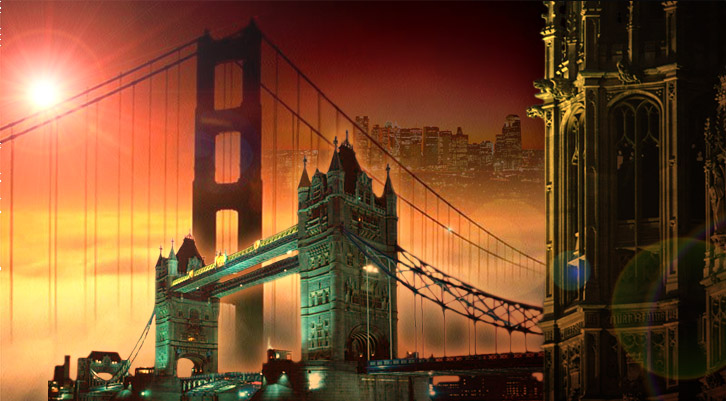 |
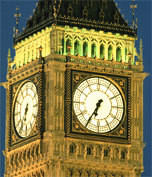 |
UK of Great Britain and Northern Ireland
Writen by student 10 "C" form Pheophanov Denis
" The best - known quality of the English, for example reserve. A reserved person is one who dose not talk very mush to strangers, dose not show much emotion."
"Cambridge is situated at a distance of seventy miles from London."
"The largest of the Stonehenge stones weigh 50 tons, and the smallest weighs 5 tons. The people who started Stonehenge were primitive. They started to build Stonehenge in about 1000 B.C. and finished it 600 years later." |
| |
UK of Great Britain and Northern Ireland |
| |
|  Plan of lecture Plan of lecture
-
The United Kingdom of Great Britain
-
Flag and symbol
- The places of interest London
3.1. Big Ban
3.2. The Houses of Parliament
3.3. Trafalgar Square
3.4. Piccadilly Circus
3.5. Westminster Abbey
3.6. St. Paul’s Cathedral
3.7. The Tower of London
- England
4.1. English Characteristics
4.2. Cambridge University
- Wales
5.1. Wales and its people. Cardiff
5.2. Some facts about welsh
5.3. Eisteddfods
- Scotland
6.1. The Scottish Thistle
6.2. Highland. Glasgow
- Stonehenge
|
| |
|
Common square - 244 046 km2.
Population - 59 100 000 men.
Capital and biggest city - London with population 6 809 000 men.
Language - English.
National symbol: The symbol of England is a rose.
The symbol of Scotland is a thistle.
The symbol of Wales is a daffodil.
The symbol of Northern Ireland is a shamrock and red hand.
|
The British Isles are group of island lying off the north - west coast of the continent of Europe. The biggest islands are Great Britain and Ireland.
England, Scotland and Wales are in island of Great Britain. The Northern Ireland is in the north - eastern part of Ireland.
There are no high mountains no these islands. In Scotland the highest mountain, is 1,343 meters high. The northern part of Scotland is called Highland, and southern pert is called Lowland. The high mountain pert of in Wales Snowdon. It is 1,085 meters high. In Ireland much of the land is low, butt here are green hills and low mountains.
The British Isles have many rivers, but they are not long. The Severn in England is the longest river. It is 350 kilometers. The climate of the British Isles is very cold in winter and never hot in summer. As a rule, there is no ice no the lakes and rivers in winter, and snow never lies on the ground for long. All parts of the British Isles get a lot of rain all seasons.
But the weather changer very often. This explains why the British people are always talking about the weather. And when they are planning to do something, they will very often say “… if it’s fine,” or “… if it’s nice weather.”
|
Map the UK Great Britain and Northern Ireland |
|
| |
|
| |
|
Big Ban
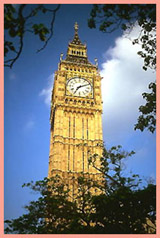 Big Ban is the name of the Clock Tower of the House of Parliament. One can gel a good view of the Tower from Westminster Bridge. The Clock Tower is 313 ft high and 41 ft square. The present clock was made by Mr. Dent. It first came into service in 1859, and, except for a few stoppage, it has it continuously every since. Big Ban is the name of the Clock Tower of the House of Parliament. One can gel a good view of the Tower from Westminster Bridge. The Clock Tower is 313 ft high and 41 ft square. The present clock was made by Mr. Dent. It first came into service in 1859, and, except for a few stoppage, it has it continuously every since.
When great bell was cast in a London foundry 1858, the question of its name was discussed in Parliament. One member said, “why not call it Big Ban?” There was mach laughter among the members because Chief Commissioner of Works at that time was Sir Benjamin Hall, a very tall stout man, whose nickname was “Big Ban”. From that time the bell has been known as Big Ban.
The Clock has four dials each 22 ft in diameters. The Bell weighs 13, 5 tons. It has four little Bens round him. Big Ban strikes only once an hour but the other four tell the quarters and the half hours. At the side of Big Ben there is a huge hammer weighing 200 kilograms. The faces of the clock are very large. The minute hands are 14ft long, the hour hands 9 ft, and the figure are 2 ft long.
The Houses of Parliament
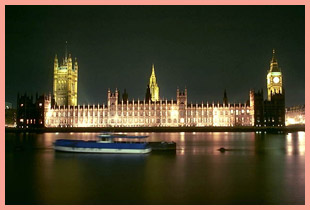 Royal Palaces and house were building along the bank of the Thames in medieval days, because the water was a busy way into and out of London. The House of Parliament, called officially the Place of Westminster, was formerly a palace of king and queens. When the king was in residence at Westminster his count was likewise in residence. There not only Royal counsils of bishops, nobles and ministers assembled, but also that very special from of Council later known as the Parliament. The place was used both a royal residence and also as a parliament house until the sixteen century. In the course of the sixteen century when the royal family moved to the new palace within hall a mile of Westminster – Whitehall Palace, the Westminster Palace was occupied by the Parliament and became its parliament home So the site of Westminster has been involved with the government of England for 500 years Royal Palaces and house were building along the bank of the Thames in medieval days, because the water was a busy way into and out of London. The House of Parliament, called officially the Place of Westminster, was formerly a palace of king and queens. When the king was in residence at Westminster his count was likewise in residence. There not only Royal counsils of bishops, nobles and ministers assembled, but also that very special from of Council later known as the Parliament. The place was used both a royal residence and also as a parliament house until the sixteen century. In the course of the sixteen century when the royal family moved to the new palace within hall a mile of Westminster – Whitehall Palace, the Westminster Palace was occupied by the Parliament and became its parliament home So the site of Westminster has been involved with the government of England for 500 years
The Parliament of the United Kingdom of Great Britain and Northern Ireland consist of the House of Lord and the House of Commons.
Trafalgar Square
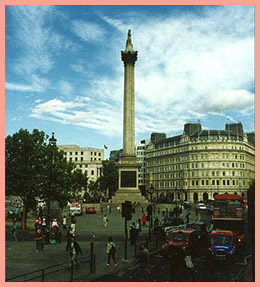 Trafalgar Square is a national centre of London. The square was named to commemorate Nelson’s victory at the Battle of Trafalgar in 1805, and monument in the center know as Nelson’s Column, is surmounted with the Statue of Nelson 16 feet high. The pedestal of the Column is decorated with bas - relief’s representing Nelson’s most famous victories. At the base of Nelson’s Column are four great lions. Trafalgar Square is a national centre of London. The square was named to commemorate Nelson’s victory at the Battle of Trafalgar in 1805, and monument in the center know as Nelson’s Column, is surmounted with the Statue of Nelson 16 feet high. The pedestal of the Column is decorated with bas - relief’s representing Nelson’s most famous victories. At the base of Nelson’s Column are four great lions.
Trafalgar Square is a national centre of London. The square was named to commemorate Nelson’s victory at the Battle of Trafalgar in 1805, and monument in the center know as Nelson’s Column, is surmounted with the Statue of Nelson 16 feet high. The pedestal of the Column is decorated with bas - relief’s representing Nelson’s most famous victories. At the base of Nelson’s Column are four great lions.
The square has now become a huge traffic island, the statue and fountains have enlivened the space so that it remains a place of pilgrimage for visitors. When the square is not used for demonstrations, it is full of visitor feeding the pigeons or watching the traffic.
On the north side of the square are the National Gallery and the National Portrait Gallery. The National Gallery has an outstanding varied collection of paintings from British, Italian, Spanish, French, Dutch and other famous schools. It is an international rather then, as it is named, a National Gallery.
Piccadilly Circus
Piccadilly Circus is square in center of London. It is called a circus because it is round, not square like many other places. This is because it is not only central but also the heard of London’s world. Within a few hundred yards of it we find most of London’s best - known theatres and cinemas entertainment most famous restaurants. Piccadilly Circus at night is a colorful sight.
Near Piccadilly Circus there is a large underground station there several different lines meet. The ticket - hall is underneath the street it has entrances from all the streets leading to the Circus.
In the evening, Piccadilly Circus is full of people going to the theater or the cinema or perhaps to a restaurant. Many others come for an evening walk; they will perhaps have a cap of coffee before the go home.
Westminster Abbey
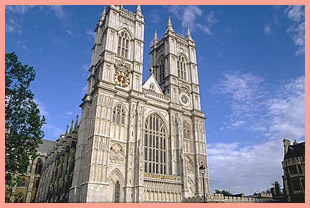 Westminster Abbey is national shrines where the kings and queens are crowned famous people are buried. Founded by Confessor in 1050, the Abbey was a monastery for a long time. The present building dates largely from time Henry III who begin rebuild church, a task which lasted nearly 300 years. The West tower was added in the eighteenth century. Since William I almost every English monarch has been crowned in this great church, which contains the tombs and memorial of many of Britain’s most eminent citizens. One of the oaken Coronation Chair made in 1300. Westminster Abbey is national shrines where the kings and queens are crowned famous people are buried. Founded by Confessor in 1050, the Abbey was a monastery for a long time. The present building dates largely from time Henry III who begin rebuild church, a task which lasted nearly 300 years. The West tower was added in the eighteenth century. Since William I almost every English monarch has been crowned in this great church, which contains the tombs and memorial of many of Britain’s most eminent citizens. One of the oaken Coronation Chair made in 1300.
Near the West Door of an Abbey the unknown Warrior lies in a simple grave commemorating the men who dead in the First World War.
The Abbey is also known for its Poets’ Corner. Graves and memorials too many English poets and writes are clustered round about.
St. Paul’s Cathedral
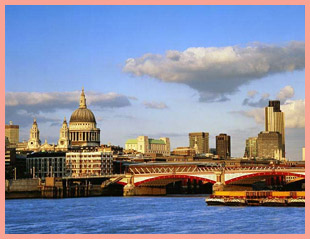 St. Paul’s Cathedral has always dominated the center of London. It stands on the site of former Saxon and Norman churches. The latter were destroyed in the Great Fire and the present building, completed in 1710, is work of the eminent architect Sir Christopher Wren. It is an architectural masterpiece. St. Paul’s Cathedral has always dominated the center of London. It stands on the site of former Saxon and Norman churches. The latter were destroyed in the Great Fire and the present building, completed in 1710, is work of the eminent architect Sir Christopher Wren. It is an architectural masterpiece.
Londoners have a particular affection for St. Paul’s, which is the largest Protestants Church in England. Its high dome, containing the remarkable Whispering Gallery, is a prominent landmark towering line the river - bank.
The Tower of London
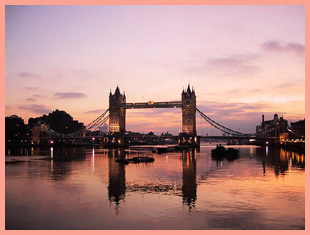 The River Thames is the main approach to London from the east. 1000 years ago William the Conqueror decided to build a strong fortress to protest the City of London, which he had just conquered. The River Thames is the main approach to London from the east. 1000 years ago William the Conqueror decided to build a strong fortress to protest the City of London, which he had just conquered.
The Tower of London was one of the first and most impressive castles build after Norman invasion of England in 1066. Since the time of William I invasions kings have built and extended the Tower of London and used it for many purposes. The Tower has been used as a royal palace, an observatory, an arsenal, a state prison, and many famous and infamous people have been executed within its walls. It is now a museum. For many visitors the principal attraction is the Crown Jewels, the finest precious stones of the nation. A fine collection of arm our is exhibited in the Keep.
The security of the tower is ensured by a million garrison and by the Yeoman Warder or «Beefeaters» who still wear their picturesque Tudor uniform.
|
| |
|
English Characteristics
The best - known quality of the English, for example reserve. A reserved person is one who dose not talk very mush to strangers, dose not show much emotion. He never tells you anything about himself. If English people are making journey by train, they will try to find an empty compartment. If they have share the compartment with a stranger, they may travel many miles without starting a conversation. If a conversation start, personal question “How old are you?” or even “What is your name?” are not easily asked. Question likes “Where did you by your watch?” or “What is your salary?” are impossible.
But people in of the North and West of Britain especially the Welsh, are much less reserved than those of the South and East.
Closely related to English reserve is English modesty. If a person is, let us say very good at tennis, and someone asks him if he is a good player, he will probably give an answer like “I’m not bad”, or “I thing I’m quite good”, or “Well, I’m very keen on tennis”.
The famous English sense of humour is well is well - known. “He is a man of hamour” or “He has no sense of hamour” is often heard in Britain.
|
Cambridge University
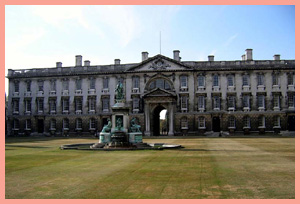 Cambridge is situated at a distance of seventy miles from London. The great part of the town lies on the left bank of the river Cam crossed by several bridges. Cambridge is situated at a distance of seventy miles from London. The great part of the town lies on the left bank of the river Cam crossed by several bridges.
In Cambridge everything centers on the University and its colleges. The University, founded in 1209, is a center of education and learning, closely connected with the life and thought of Great Britain. Newton, Byron, Darwin, Rutherford and many other scientists and writers were educated at Cambridge University.
There is a close connection between the University and the colleges, though they are quite separate.
A college is a group of buildings forming a square with a green lawn in the center. An old tradition dose not allows the students to walk on the grass; this is the privilege of profession only. There is another tradition which the students must follow: after sunset they are not allowed to go out without wearing a black cap and black coat.
The college is a place where the students live; no matter what profession they are trained for. So students studying literature and those trained for physics may belong to the some college. Every college is headed by a dean. To be a member of the University one must be a member of a college.
The University organizes most of the teaching. The various subjects of study are controlled by faculties and the teaching is done by professors, readers and lectures. The University has about 7000 students, who are trained by tutors; each tutor has 10 or 12 students.
The students study at the university for 4 years, three terms a year.
|
| |
|
Wales and its people.
Cardiff
 In the west of Britain one of the most beautiful part of the British Isles lies - Wales. In the west of Britain one of the most beautiful part of the British Isles lies - Wales.
In North Wales, there are a lot of mountains and valleys, where you can see a lot of seep - and not many people. Snowdon, the highest mountain in Wales, is in the north. So, in North Wales, you can walk the mountain and swim in the lake, too, if you lake cold water.
In Souse Wales, most people work in industry, or in the coalmines. Cardiff - this is a capital of Wales. Cardiff and Swansea are both big port, and ships come to the ports from all part of the world. Port Talbot is the centre of the steel industry.
The Language of the people of Wales is Walsh, but most of them speak English too. Some Walsh people learn their own language before they lean English, and of them never learn much English. You can listen to a conversation in Welsh, and hear only a few English words here and there, so you may not understand it. Welsh people are proud of their national language.
Some facts about the Welsh
People in Wales speak in English, but they have their own language, too. Some Walsh famlies speak Walsh to each other at home, but they read English newspaper and English book. You can listen to a conversation in Welsh, and suddenly hear English words like “terrible” or “car”.
Walsh people are very proud of their national language and culture and they are very proud of Wales too.
What do the Welsh wear? They wear the same thing as the English except on special occasion. Then a Welsh woman wears a red cloak, a long skirt, an apron, and high black hat no her head. The men do not have a national costume.
“Jones” is a very common Welsh family name, so are “Williams”, “Morgan” and “Evans”. That is why Welsh people in villages often call people by they job, as well as by family name. Then everybody knows which Jones or which William they are talking about. You can guess what “Jones the Meat”, “William the Bread” and “Morgan the Fish” do.
Eisteddfods
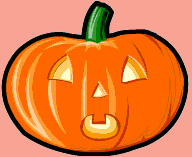 Every year, in August, there is a National eisteddfod in Wales. Every year, in August, there is a National eisteddfod in Wales.
What is eisteddfod? It is a meeting of Welshmen interested in Welsh poetry, Welsh songs and music. One year it’s in a town in north Welsh; the next year it’s in town in South Welsh. It lasts for a week. Between 10000 and 15000 people come to the eisteddfod every day. Some want to listen to the poem; some want to listen to the singing; and some just want to meet their friends and talk in Welsh. Welsh people from many countries come bask to Wales for the National eisteddfod. You won’t hear much English at an eisteddfod.
There is competition at an eisteddfod, too: for the best Welsh poem and song of the year, and the best singer. The competitions are organized by the Druids. The Druids wear long robes; their leader is always a poet.
About a hundred years ago, some Welsh people became very interested in the old traditions of Welsh. They decided to perform of the old traditions and ceremonies at eisteddfod.
Welsh traditions are very old, and the Welsh people are very proud of them.
|
| |
|
The Scottish Thistle
The Thistle is the national emblem of Scotland. This is how it came to be chosen as the emblem.
Long, long ago the Norsemen once landed on the east coast of Scotland with the aim to settle in the country. The Scots assembled to defend their country behind the river Tay, the largest in Scotland. As they arrived late in the day, tired after a long mach, they camped by the river and rested, not expecting the enemy before the next day.
The Norseman however was near. They decided to cross the Tey, take the Scots by surprise and attack them in their sleep. To this end, they took off their shoes so as to make the least noise possible. But one of the Norseman stepped on a thistle and shrieked loudly.
The Scots wore up, and the Norsemen were put to flight. For this timely and unexpected help the Scots took the thistle their national emblem.
Highland. Glasgow
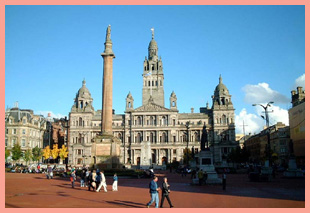 The most interesting and beautiful part of Scotland - and of the whole of Britain, perhaps, is the north and west, or the region usually called “the highlands and islands”. The most interesting and beautiful part of Scotland - and of the whole of Britain, perhaps, is the north and west, or the region usually called “the highlands and islands”.
Most of the large Scottish towns and cities are in the Lowlands (the South of Scotland). This is mainly an industrial region. Glasgow is the biggest city in Scotland and one of the largest cities in Britain.
The Highlands are in the north of Scotland. This is a region of mountains and rivers, small town and villages. The Highlands are a country of great sea - lochs. On the sides of some of the lochs there are farm which came only be reached by boat.
A lot of Scottish family names start with “Mac” or “Mc” - like McDonald, Macmillan, or McHale. And “Jook” is a popular Scottish name for John, or Jack.
Some man in the north Scotland wear a kilt every day, but in other parts of the wear just the same clothes as the English.
The Scots speak in English, but with their own accent. For example, when a Scots says the word “arm”, he says “ar-r-m”, so that you can hear the sound [r].
The Highlanders are fond Highland games. When the Games begin, local people march several kilometers round the villages in their district before they rich the place of the Games. Their pipers march in front, playing the bagpipers.
The Highlands who take part in the Games are very big, strong men. At Highlands Games, they do things like Throwing the Hammer, for example, or Tossing the Caber. The hammer is very large, and very heavy; the caber is like a telegraph pole.
|
| |
|
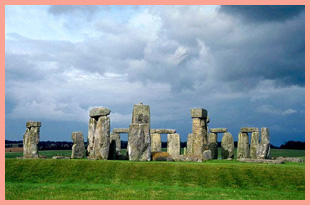 About 4600 years ago - or maybe more - the Stone Age inhabitants of Britain started an enormous stone structure. This structure is now called Stonehenge, and it is near Salisbury, in the South of England. About 4600 years ago - or maybe more - the Stone Age inhabitants of Britain started an enormous stone structure. This structure is now called Stonehenge, and it is near Salisbury, in the South of England.
The largest of the Stonehenge stones weigh 50 tons, and the smallest weighs 5 tons. The people who started Stonehenge were primitive. They used no metal and their tools were made only of stone, bone and wood. Those primitive people usually spent all day, from sunrise to sunset, hunting, fishing and growing crops.
They started to build Stonehenge in about 1000 B.C. and finished it 600 years later. Thousands of man and woman took parting building it.
They builders of Stonehenge could not read or write, so they have left us no records of the work. And we do not know how Stonehenge was build.
|
| |
|
|
| |


 Plan of lecture
Plan of lecture
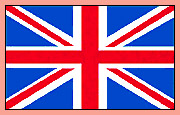
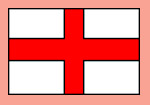
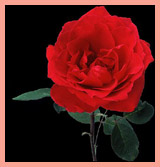

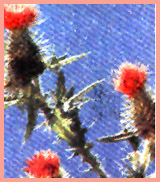

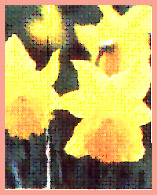

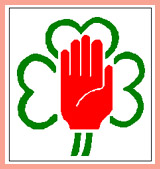





 The River Thames is the main approach to London from the east. 1000 years ago William the Conqueror decided to build a strong fortress to protest the City of London, which he had just conquered.
The River Thames is the main approach to London from the east. 1000 years ago William the Conqueror decided to build a strong fortress to protest the City of London, which he had just conquered. 
 In the west of Britain one of the most beautiful part of the British Isles lies - Wales.
In the west of Britain one of the most beautiful part of the British Isles lies - Wales. Every year, in August, there is a National eisteddfod in Wales.
Every year, in August, there is a National eisteddfod in Wales. The most interesting and beautiful part of Scotland - and of the whole of Britain, perhaps, is the north and west, or the region usually called “the highlands and islands”.
The most interesting and beautiful part of Scotland - and of the whole of Britain, perhaps, is the north and west, or the region usually called “the highlands and islands”. About 4600 years ago - or maybe more - the Stone Age inhabitants of Britain started an enormous stone structure. This structure is now called Stonehenge, and it is near Salisbury, in the South of England.
About 4600 years ago - or maybe more - the Stone Age inhabitants of Britain started an enormous stone structure. This structure is now called Stonehenge, and it is near Salisbury, in the South of England.